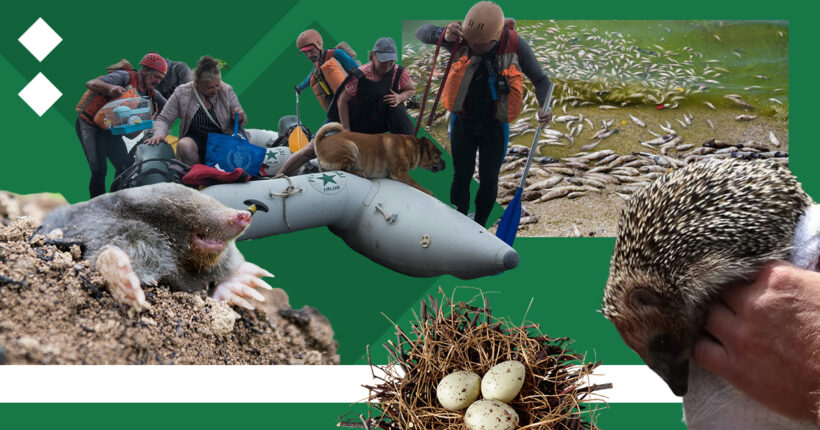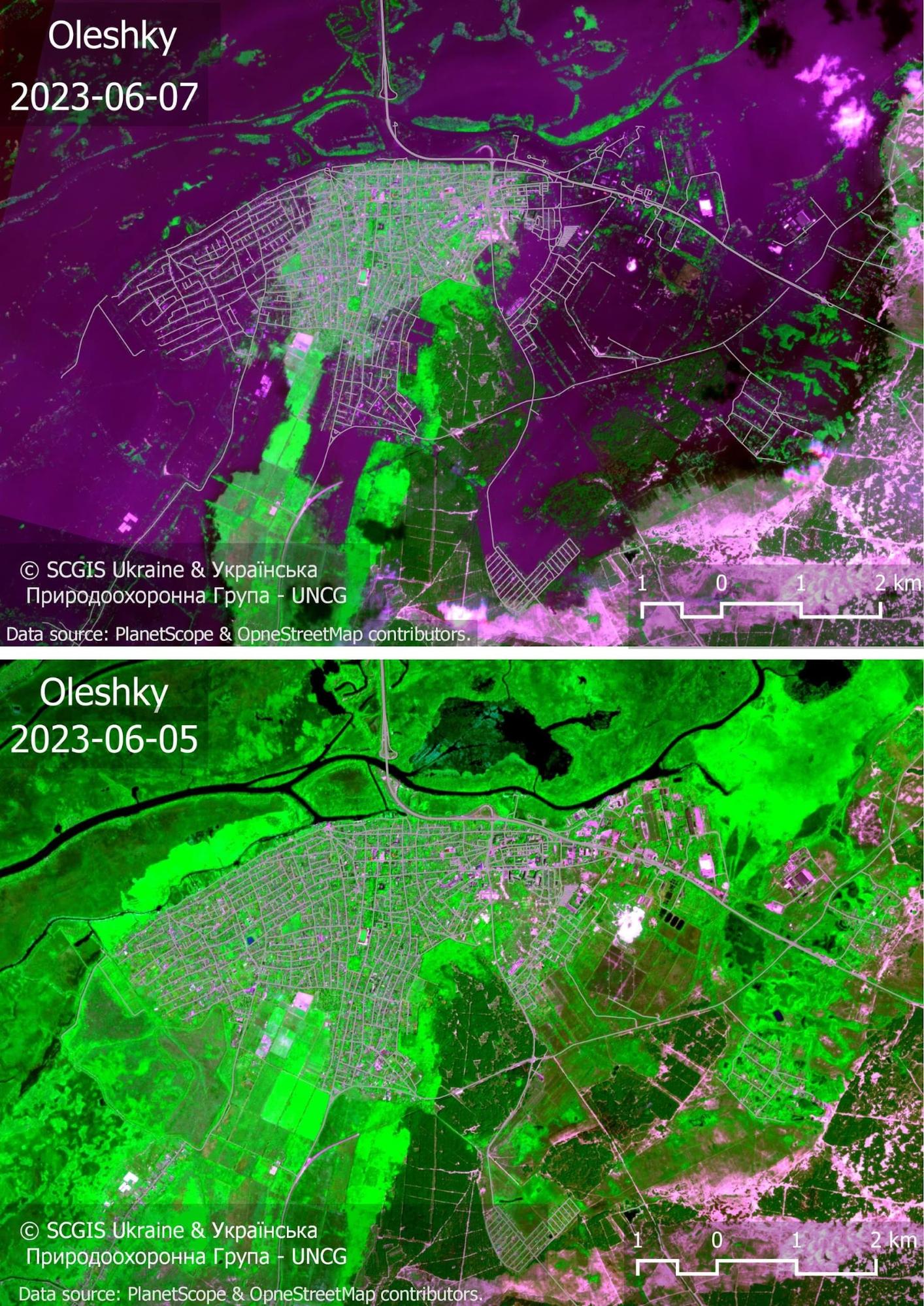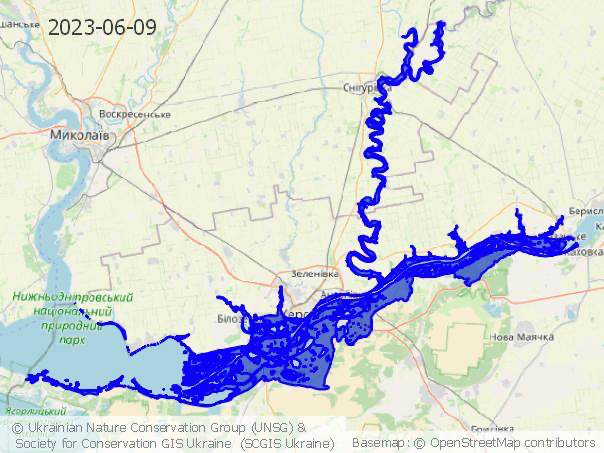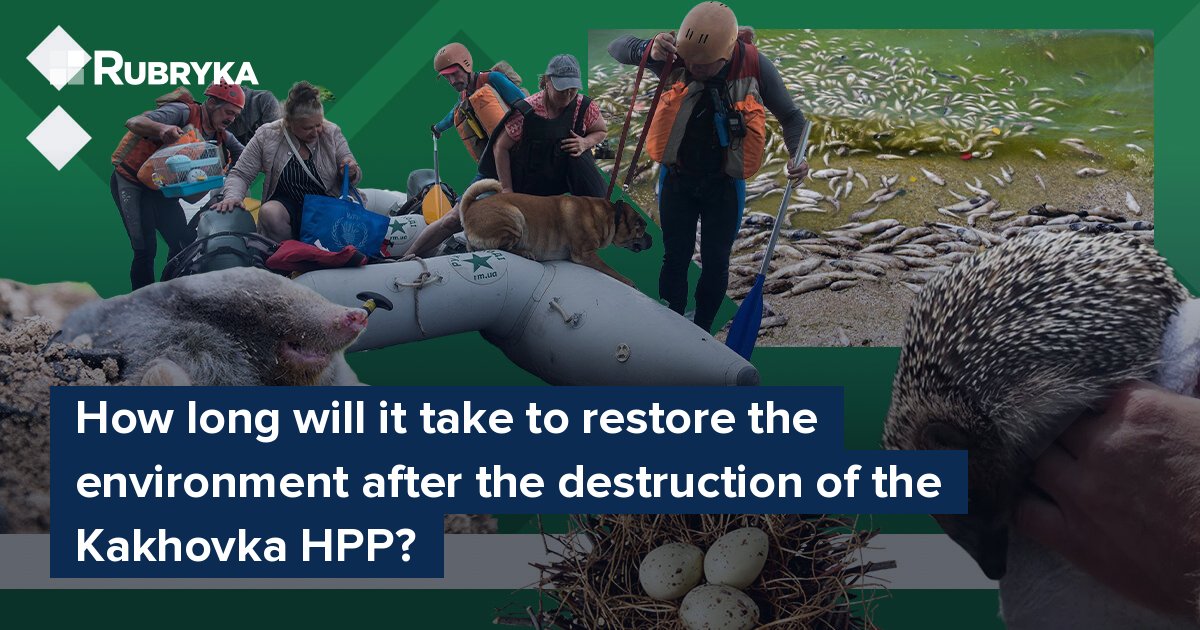
What is the problem?
Due to the destruction of the Kakhovka HPP, hundreds of species of living organisms were jeopardized, including 71 animals and 32 plants registered on the IUCN's World Red List, the European Red List, the Ukrainian Red Book, and Kherson region's Red List.

Resolution satellite images of June 6 (bottom) and June 7 (top) depicting the area before and after the explosion of the Kakhovka HPP dam are presented. Water is represented by a purple color, land by a green color, and white lines signify roads based on conventional designations. The authors of the picture are the United Nations Secretary-General (UNSG) and the Society for Conservation GIS (SCGIS) Ukraine.
Vladyslav Balinskyi, an ecologist, stated that the consequences of undermining the Kakhovka Reservoir's dam would have a significant global ecological impact in the Black Sea area. He went on to explain that the exclusive natural environment of the Dnipro River floodplain — spanning from Nova Kakhovka to the Dnipro-Buzka Delta, an area of roughly 80,000 hectares referred to as the "Lower Dnipro" zone — has actually been destroyed.

Schematic representation of the flooded area. The Kherson and Mykolaiv regions (Ingulets Valley) have recently been subjected to extensive flooding, with the total surface area estimated as of 9 June 2020 to be 55,459 hectares (554.6 km²). Author of the picture: SCGIS Ukraine
Small mammals, which were already at the stage of extinction, remained underwater
The undermining of the dam of the Kakhovsky Reservoir is another factor that can affect the destruction of various species of animals because the hostilities in the South of Ukraine, which are still ongoing, also affect the number of populations of various species of animals.
So, for example, small rodents, such as sand vole, Nordmann's birch mouse, and the Falz-Fein jerboa are endemic species of the Ukrainian steppe that are found only in these areas. The last two species are defined as endangered in the Red List.
"There has been a catastrophic impact on the populations of globally endangered mammal species. Thus, 70% of the world population of Nordmann's mouse was flooded, which may lead to its disappearance in the future. Up to 50% of the population of the sand stilt, up to 50% of the population of the Falz-Fein's jerboa have been destroyed," commented Oleksiy Vasyliuk, the head of the Ukrainian Nature Protection Group, on the threat posed by the dam's undermining to small mammals.
Kherson Region could potentially face the loss of certain species of birds due to their inability to nest in the region
According to the ecologist Vladyslav Balinsky, the mating season of birds and the nesting period are threatened.
Oleksiy Vasyliuk, the head of the Ukrainian Nature Protection Group, reached the same conclusion in his report on the consequences of detonating the hydroelectric power station. His findings predicted that due to the almost complete disappearance of the Kakhov reservoir, numerous avian species that traditionally nest in the region would face destabilized habitats and potential extinction. Additionally, species utilizing the flood zone are also at risk, with an estimated tens of thousands of individuals affected by the dam's destruction.
"It is in the floodplains of the lower Dnipro that the region's largest colonies of herons and other colonial birds are concentrated. It should be noted that the disastrous effect [of the dam's destruction – ed.] on bird nesting during the nesting period, particularly the presence of chicks, is immense. There's no time to form new colonies and breed again. Repeating nests will not produce chicks that are able to migrate by the end of summer," the expert explains.
We have lost a massive amount of freshwater fish
According to ecologist Oleksiy Vasyliuk, the impact of the disaster on fish resources is one of the biggest. He writes about this in his report on the consequences of blowing up the HPP:
"The Kakhovka Reservoir, as well as the Nyhny Dnipro floodplains, are among the largest concentrations of freshwater commercial fish species in Ukraine. At the time of the terrorist attack, no less than 43 fish species were counted in the Kakhovka Reservoir alone, of which 20 species are of industrial importance (annual catch was up to 2.6 thousand tons)," comments the expert.
Oleksiy Vasyliuk also explains that all the spots where fish spawn and the main body of water that serves as their habitat have been destroyed. Most species spawn at the end of spring or the start of summer, so that's when the ban on fishing – which includes a "quiet" rule regarding motor vessels and other restrictions – is enforced. Because the reservoir was emptied so quickly, all the young fish ended up in the shallow, drained areas with no chance of survival.Moreover, due to the shallowing of the Kakhovka Reservoir, the winter pit in the water area of the Republican Bay within the Kamianska Sich National Nature Park probably won't exist anymore. The winter pits in the water areas of Havrilivska, Dudchanska bays, and the bays near Novovorontsovka (next to the park boundary) are also likely to suffer the same fate.
"The vast majority of all fish that inhabited the reservoir will be taken to the sea and die in the salty water," Oleksiy Vasyliuk believes.
Confirmation of these statements regrettably exists already. On June 7, the Ministry of Health of Ukraine declared a massive fish die-off in the Dnipropetrovsk region, and people shared videos of a mass plague of fish on social networks.
What is the solution?
Nature is the best restorer of itself. In time, natural resources will recuperate.
Oleksiy Vasyliuk says that some birds will lose their nesting colonies from the disaster, but they can build their numbers back up in 3 to 7 years. Harrier predators will take even longer to restore their population, 5 to 10 years. Fish stocks will require the longest to return to normal numbers — at least 7 to 10 years.
"Objectively, to restore something, you don't need to change a thing. Nature does a better job of restoring itself than we ever could. Biodiversity is thousands of species and tens of thousands of connections that we could never hope to replicate," — Oleksiy Vasyliuk explains to Rubryka.
Something needs to be done as soon as possible to help protect people's health: we need to get grass planted on the bottom of the reservoir right away
The Ministry of Health of Ukraine stated that, at the bottom of the Kakhovka HPP, there could be many health-hazardous substances that, if detonated, could be incredibly dangerous and jeopardize people's health in the flooded territories.
It concerns the heavy metals and other pollutants from industrial sites in Zaporizhzhia, Dnipro, and Kamianske that have built up on the reservoir floor. Ecologist Oleksiy Vasyliuk remarks:
"For decades, [industrial] waste from Zaporizhzhia settled there, and a huge amount of heavy metals settled in the mud. Since there was no current in the reservoir, it all remained at the bottom, but now the current takes everything, lifts it into the water column, and moves it on. All of this will be below, downstream, and in the sea. The wind will blow away everything that remains at the bottom of the reservoir and dries up," Oleksiy Vasyliuk explains to Rubryka. All these metals can be absorbed into plants that people and animals eat and spread over large areas. However, this can be prevented.
The scientist suggests it's essential to immediately sow grasses and create meadows on the reservoir bed in vulnerable areas.
"This can save the area from turning into a toxic desert. Therefore, it is urgently necessary to sow grass to populate the sands that will become bare and prevent them from spreading around," Vasyliuk explains. These can be natural grass blends which are typical for Ukrainian meadows.
Until the grass is sown: how to protect health?
News about exciting discoveries from the depths of the Kakhovka Reservoir is already appearing online, along with some eye-catching photos. Be warned, though, walking on the bare bottom; you are getting too close to the harmful sediment. These safety rules can help keep you safe:
- It's better to keep the windows shut when it's windy so that dust-carrying harmful particles don't get into the house.
- Do more wet cleaning.
- Do not go outside during dust storms.
- Monitor air quality. This can be done with the help of SaveEcoBot public monitoring stations.
Newsletter
Digest of the most interesting news: just about the main thing







